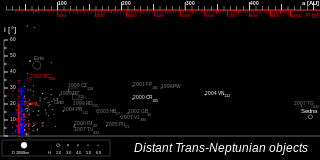Related Research Articles

The Solar System is the gravitationally bound system of the Sun and the objects that orbit it. The largest of such objects are the eight planets, in order from the Sun: four terrestrial planets, named Mercury, Venus, Earth and Mars; and four giant planets, including two gas giants, Jupiter and Saturn, and two ice giants, named Uranus and Neptune. The terrestrial planets have a definite surface and are mostly made of rock and metal. The gas giants are mostly made of hydrogen and helium, while the ice giants are mostly made of volatile substances such as water, ammonia, and methane. In some texts, these terrestrial and giant planets are called the inner Solar System and outer Solar System planets respectively.

Pluto is a dwarf planet in the Kuiper belt, a ring of bodies beyond the orbit of Neptune. It is the ninth-largest and tenth-most-massive known object to directly orbit the Sun. It is the largest known trans-Neptunian object by volume, by a small margin, but is slightly less massive than Eris. Like other Kuiper belt objects, Pluto is made primarily of ice and rock and is much smaller than the inner planets. Pluto has only one sixth the mass of Earth's moon, and one third its volume.

Gerard Peter Kuiper was a Dutch-American astronomer, planetary scientist, selenographer, author and professor. He is the eponymous namesake of the Kuiper belt.

Asteroid impact avoidance comprises the methods by which near-Earth objects (NEO) on a potential collision course with Earth could be diverted away, preventing destructive impact events. An impact by a sufficiently large asteroid or other NEOs would cause, depending on its impact location, massive tsunamis or multiple firestorms, and an impact winter caused by the sunlight-blocking effect of large quantities of pulverized rock dust and other debris placed into the stratosphere. A collision 66 million years ago between the Earth and an object approximately 10 kilometres wide is thought to have produced the Chicxulub crater and triggered the Cretaceous–Paleogene extinction event that is understood by the scientific community to have caused the extinction of all non-avian dinosaurs.

Mare Orientale is a lunar mare. It is located on the western border of the near side and far side of the Moon, and is difficult to see from an Earthbound perspective. Images from spacecraft have revealed it to be one of the most striking large scale lunar features, resembling a target ring bullseye.

Steven Jeffrey Ostro was an American scientist specializing in radar astronomy. He worked at NASA's Jet Propulsion Laboratory. Ostro led radar observations of numerous asteroids, as well as the moons of Jupiter and Saturn, Saturn's rings, and Mars and its satellites. As of May 2008, Ostro and his collaborators had detected 222 near-Earth asteroids and 118 main belt objects with radar.

Sedna is a dwarf planet in the outermost reaches of the Solar System discovered in 2003. Spectroscopy has revealed that Sedna's surface composition is largely a mixture of water, methane, and nitrogen ices with tholins, similar to those of some other trans-Neptunian objects. Its surface is one of the reddest among Solar System objects. Sedna, within estimated uncertainties, is tied with Ceres as the largest planetoid not known to have a moon. It has a diameter of approximately 1,000 km, with an unknown mass.

David Clifford Jewitt is a British-American astronomer who studies the Solar System, especially its minor bodies. He is based at the University of California, Los Angeles, where he is a Member of the Institute for Geophysics and Planetary Physics, the Director of the Institute for Planets and Exoplanets, Professor of Astronomy in the Department of Physics and Astronomy and Professor of Astronomy in the Department of Earth, Planetary and Space Sciences. He is best known for being the first person to discover a body beyond Pluto and Charon in the Kuiper belt.

Makemake is a dwarf planet and the second-largest of what are known as the classical population of Kuiper belt objects, with a diameter approximately that of Saturn's moon Iapetus, or 60% that of Pluto. It has one known satellite. Its extremely low average temperature, about 40 K (−230 °C), means its surface is covered with methane, ethane, and possibly nitrogen ices.

Peter Goldreich is an American astrophysicist whose research focuses on celestial mechanics, planetary rings, helioseismology and neutron stars. He is the Lee DuBridge Professor of Astrophysics and Planetary Physics at California Institute of Technology. Since 2005 he has also been a professor at the Institute for Advanced Study in Princeton, New Jersey. Asteroid 3805 Goldreich is named after him.
Robin M. Canup is an American astrophysicist. Her main area of research concerns the origins of planets and satellites. In 2003, Canup was awarded the Harold C. Urey Prize. In April, 2022, Canup presented the findings of the Planetary Science Decadal Survey as co-chair of the Survey Steering Committee with Philip R. Christensen.

Detached objects are a dynamical class of minor planets in the outer reaches of the Solar System and belong to the broader family of trans-Neptunian objects (TNOs). These objects have orbits whose points of closest approach to the Sun (perihelion) are sufficiently distant from the gravitational influence of Neptune that they are only moderately affected by Neptune and the other known planets: This makes them appear to be "detached" from the rest of the Solar System, except for their attraction to the Sun.

Gonggong (formally 225088 Gonggong; provisional designation 2007 OR10) is a dwarf planet, a member of the scattered disc beyond Neptune. It has a highly eccentric and inclined orbit during which it ranges from 34–101 astronomical units (5.1–15.1 billion kilometers; 3.2–9.4 billion miles) from the Sun. As of 2019, its distance from the Sun is 88 AU (13.2×109 km; 8.2×109 mi), and it is the sixth-farthest known Solar System object. According to Deep Ecliptic Survey Gonggong is in a 3:10 orbital resonance with Neptune, in which it completes three orbits around the Sun for every ten orbits completed by Neptune. Gonggong was discovered in July 2007 by American astronomers Megan Schwamb, Michael Brown, and David Rabinowitz at the Palomar Observatory, and the discovery was announced in January 2009.

(4953) 1990 MU is a large Earth-crossing asteroid (ECA) belonging to the Apollo group of near-Earth objects which also cross the orbits of Mars and Venus. At approximately 3 km in diameter, it is one of the largest known ECAs. It has been assigned a permanent number from the Minor Planet Center (4953) indicating that its orbit has been very well determined. With an observation arc of 45 years, the asteroid's trajectory and uncertainty regions are well known through to the year 2186.
Michael J. S. Belton was President of Belton Space Exploration Initiatives and Emeritus Astronomer at the Kitt Peak National Observatory in Arizona. Belton served as the Chair of the 2002 Planetary Science Decadal Survey guiding NASA and other US Government Agencies plans for solar system exploration. Belton studied first at the University of St. Andrews in Scotland and earned his PhD at the University of California at Berkeley for his doctoral thesis on "The Interaction of Type II Comet Tails with the Interplanetary Medium".
Dale P. Cruikshank is an astronomer and planetary scientist in the Astrophysics Branch at NASA Ames Research Center. His research specialties are spectroscopy and radiometry of planets and small bodies in the Solar System. These small bodies include comets, asteroids, planetary satellites, dwarf planets, and objects in the region beyond Neptune. He uses spectroscopic observations made with ground-based and space-based telescopes, as well as interplanetary spacecraft, to identify and study the ices, minerals, and organic materials that compose the surfaces of planets and small bodies.

Patrick Michel is a French planetary scientist, Senior Researcher at CNRS, leader of the team TOP of the Lagrange Laboratory at the Côte d'Azur Observatory in Nice (France) and also a Global Fellow of the University of Tokyo.

486958 Arrokoth (provisional designation 2014 MU69; formerly nicknamed Ultima Thule) is a trans-Neptunian object located in the Kuiper belt. Arrokoth became the farthest and most primitive object in the Solar System visited by a spacecraft when the NASA space probe New Horizons conducted a flyby on 1 January 2019. Arrokoth is a contact binary 36 km (22 mi) long, composed of two planetesimals 21 and 15 km (13 and 9 mi) across, that are joined along their major axes. With an orbital period of about 298 years and a low orbital inclination and eccentricity, Arrokoth is classified as a cold classical Kuiper belt object.
References
- ↑ Charles W. Carey (1 January 2006). American Scientists. Infobase Publishing. pp. 211–. ISBN 978-1-4381-0807-0 . Retrieved 17 August 2013.
- ↑ Committee to Review Near-Earth Object Surveys and Hazard Mitigation Strategies; Space Studies Board; National Research Council (21 June 2010). Defending Planet Earth: Near-Earth Object Surveys and Hazard Mitigation Strategies. National Academies Press. pp. 138–. ISBN 978-0-309-15721-6 . Retrieved 17 August 2013.